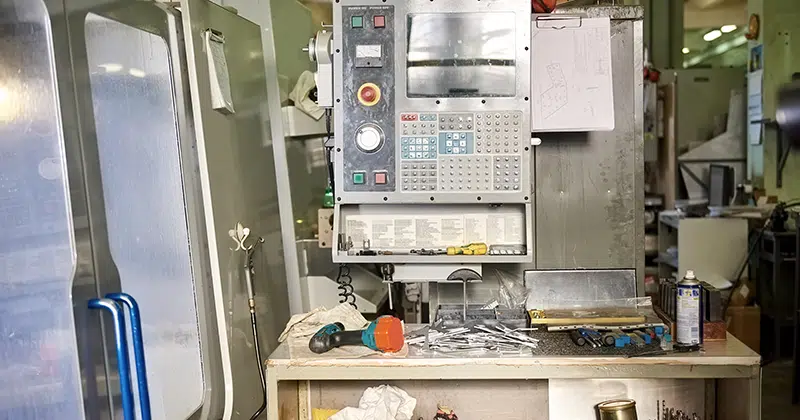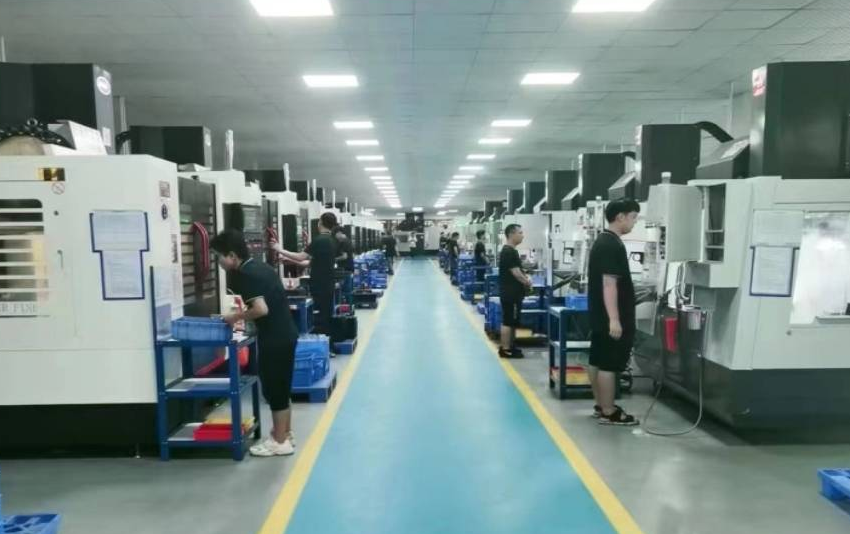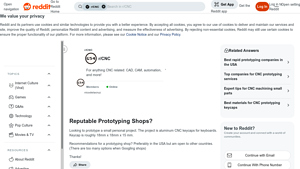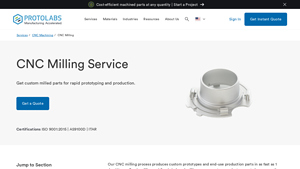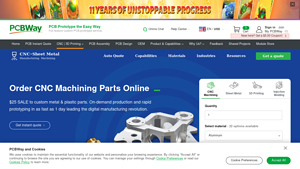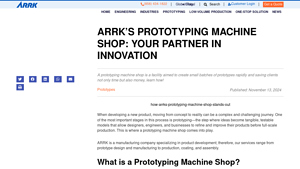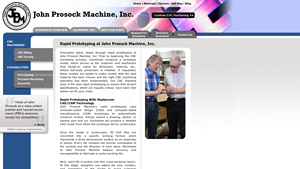Prototyping Machine Shop Guide: Type, Cost, Top List…
Introduction: Navigating the Global Market for prototyping machine shop
In today’s fast-paced global market, sourcing reliable prototyping machine shops can be a daunting challenge for B2B buyers, especially those operating in diverse regions such as Africa, South America, the Middle East, and Europe. The demand for high-quality prototypes is ever-increasing, driven by the need for innovation and rapid product development. This guide aims to simplify the process by providing a comprehensive overview of the prototyping machine shop landscape, including types of services offered, applications across various industries, supplier vetting strategies, and cost considerations.
Understanding the nuances of prototyping is crucial for making informed purchasing decisions. From CNC machining to additive manufacturing, each method has unique benefits that can significantly impact project timelines and product quality. This guide not only details the capabilities of different machine shops but also emphasizes the importance of evaluating suppliers based on certifications, material availability, and production capabilities.
By leveraging this guide, international B2B buyers can navigate the complexities of the prototyping landscape with confidence, ensuring that they select the right partner to meet their specific needs. Whether you are in Brazil seeking rapid prototyping solutions or in Saudi Arabia looking for advanced machining capabilities, this resource is designed to empower you with the insights necessary to foster successful business relationships and drive innovation in your projects.
Understanding prototyping machine shop Types and Variations
| Type Name | Key Distinguishing Features | Primary B2B Applications | Brief Pros & Cons for Buyers |
|---|---|---|---|
| CNC Machining Shops | Utilizes computer-controlled machines for precision cutting | Functional prototypes, custom parts | Pros: High precision, quick turnaround. Cons: Initial setup costs can be high. |
| 3D Printing Services | Employs additive manufacturing for rapid prototyping | Concept models, low-volume production | Pros: Cost-effective for complex designs. Cons: Limited material strength for some applications. |
| Injection Molding Shops | Specialized in producing parts through mold injection | High-volume production, consumer goods | Pros: Economical for large quantities. Cons: High upfront costs for mold creation. |
| Sheet Metal Fabrication | Focuses on cutting, bending, and assembling metal sheets | Enclosures, brackets, structural parts | Pros: Versatile for various applications. Cons: May not be suitable for intricate designs. |
| Hybrid Prototyping Shops | Combines various methods (CNC, 3D printing, etc.) | Complex assemblies, mixed-material parts | Pros: Flexible and adaptable. Cons: Potentially longer lead times. |
What Are CNC Machining Shops and Their B2B Suitability?
CNC machining shops are equipped with advanced computer-controlled machines that allow for high-precision cutting and shaping of materials. These shops are particularly suitable for producing functional prototypes and custom parts across various industries, including automotive, aerospace, and medical devices. When considering a CNC machining service, B2B buyers should evaluate the shop’s capabilities in terms of tolerances, material options, and turnaround times, as these factors directly impact the final product’s quality and cost-effectiveness.
How Do 3D Printing Services Benefit B2B Buyers?
3D printing services leverage additive manufacturing techniques to create prototypes and parts layer by layer. This method is especially advantageous for producing complex geometries and low-volume runs. B2B buyers can benefit from reduced material waste and faster prototyping cycles. However, it’s crucial to assess the mechanical properties of the printed parts, as some materials may not be suitable for high-stress applications. Understanding the service’s material offerings and post-processing capabilities can help buyers make informed decisions.
What Are the Advantages of Injection Molding Shops for High-Volume Production?
Injection molding shops specialize in creating parts by injecting molten material into a pre-designed mold. This technique is ideal for high-volume production, making it a popular choice for consumer goods and automotive components. While the initial costs for mold development can be significant, the per-unit cost decreases dramatically with larger production runs. Buyers should consider the lead time for mold creation and the shop’s ability to handle design modifications during the production phase.
Why Choose Sheet Metal Fabrication for Versatile Applications?
Sheet metal fabrication involves cutting, bending, and assembling metal sheets to create various components. This approach is versatile, suitable for producing enclosures, brackets, and structural parts across industries. B2B buyers should evaluate the fabrication shop’s capabilities in terms of material types and thicknesses, as well as its ability to handle custom designs. While sheet metal fabrication is ideal for straightforward shapes, intricate designs may require additional processes, which could affect timelines and costs.
What Makes Hybrid Prototyping Shops a Flexible Option for Complex Projects?
Hybrid prototyping shops combine multiple manufacturing methods, such as CNC machining and 3D printing, to create complex assemblies and mixed-material parts. This flexibility allows for rapid iterations and adaptations to design changes, making them suitable for projects with evolving requirements. Buyers should consider the shop’s experience with different technologies and its capacity to manage longer lead times, which may arise from coordinating various production methods. Understanding the integration process is key to ensuring project success.
Key Industrial Applications of prototyping machine shop
| Industry/Sector | Specific Application of Prototyping Machine Shop | Value/Benefit for the Business | Key Sourcing Considerations for this Application |
|---|---|---|---|
| Automotive | Development of functional prototypes for components | Accelerates product development and reduces time-to-market | Material compatibility, precision tolerances, and certifications |
| Aerospace | Creation of jigs and fixtures for assembly | Enhances manufacturing efficiency and accuracy | Compliance with industry standards (e.g., AS9100), material selection |
| Medical Devices | Prototyping of surgical instruments and implants | Ensures safety and efficacy in product design | Biocompatibility of materials, regulatory compliance, and rapid turnaround |
| Consumer Electronics | Production of prototypes for product testing | Facilitates user feedback and design iterations | Design complexity, surface finish requirements, and cost-effectiveness |
| Industrial Equipment | Custom prototypes for machinery components | Improves operational efficiency and reduces downtime | Durability of materials, precision engineering, and scalability options |
How is Prototyping Machine Shop Used in Automotive Development?
In the automotive sector, prototyping machine shops play a crucial role in developing functional prototypes for various components, such as engine parts and chassis elements. These prototypes allow manufacturers to test fit, form, and function before committing to mass production. By employing advanced CNC machining techniques, businesses can significantly accelerate their product development cycle, effectively reducing time-to-market. Buyers in this sector must consider material compatibility and precision tolerances to ensure prototypes meet stringent automotive standards.
What Role Does Prototyping Play in Aerospace Manufacturing?
Aerospace companies utilize prototyping machine shops for creating jigs and fixtures essential in the assembly of aircraft components. These tools enhance manufacturing efficiency and accuracy, which is vital in an industry where precision is paramount. Prototyping helps identify potential design flaws early, minimizing costly revisions later. For international buyers, compliance with industry standards, such as AS9100, and careful selection of materials are critical factors in sourcing prototypes that meet rigorous safety and performance criteria.
Why is Prototyping Important for Medical Device Development?
In the medical devices sector, prototyping machine shops facilitate the development of surgical instruments and implants. The ability to create accurate prototypes ensures that products meet safety and efficacy standards required by regulatory bodies. Rapid prototyping allows for iterative testing and refinement, which is essential in developing devices that can withstand clinical scrutiny. Buyers must prioritize biocompatibility of materials and adhere to regulatory compliance to ensure successful product development and market entry.
How Do Prototyping Services Benefit Consumer Electronics?
Prototyping machine shops are integral to the consumer electronics industry, where rapid production of prototypes for product testing is essential. These prototypes enable manufacturers to gather user feedback and make necessary design iterations before full-scale production. This iterative process helps in minimizing market risks and aligning products with consumer expectations. Buyers should focus on design complexity, surface finish requirements, and cost-effectiveness to optimize their prototyping efforts.
What is the Value of Prototyping in Industrial Equipment?
In the industrial equipment sector, prototyping machine shops are used to create custom prototypes for machinery components. This application is vital for improving operational efficiency and reducing downtime during production. By testing prototypes, manufacturers can identify design flaws and optimize performance before final production. Buyers should consider the durability of materials, precision engineering capabilities, and scalability options to ensure their prototypes meet the demands of heavy-duty applications.
3 Common User Pain Points for ‘prototyping machine shop’ & Their Solutions
Scenario 1: Difficulty in Getting Timely Quotes for Prototyping Needs
The Problem: One common challenge faced by B2B buyers when sourcing services from prototyping machine shops is the lengthy and unclear quoting process. Buyers often require rapid prototyping for new product development but can be hindered by slow response times from suppliers. This delay can lead to missed deadlines, increased costs, and frustration, particularly when the buyer is under pressure to deliver prototypes for client evaluations or market testing.
The Solution: To overcome this problem, buyers should look for prototyping machine shops that offer instant online quoting tools. By utilizing shops that allow users to upload CAD designs directly and receive quotes in real time, buyers can significantly reduce the time spent waiting for pricing information. When selecting a shop, ensure they provide transparent pricing structures without hidden fees. Additionally, consider establishing a direct line of communication with the shop’s representatives for urgent requests. This proactive approach enables quicker adjustments to designs or specifications, ensuring that any changes are addressed promptly. Furthermore, leveraging shops that have automated systems for order processing can enhance efficiency and speed up delivery timelines.
Scenario 2: Inconsistent Quality and Tolerances in Prototyped Parts
The Problem: Another prevalent issue is the inconsistency in the quality and tolerances of the machined parts produced by different prototyping shops. Buyers often face challenges when parts do not meet the required specifications, leading to costly rework, delays, and compromised project timelines. This inconsistency can arise from a lack of standardized processes or inadequate machinery, which is particularly concerning for industries where precision is critical, such as aerospace or medical devices.
The Solution: To mitigate this risk, buyers should prioritize working with prototyping machine shops that have robust quality assurance processes in place. Look for certifications such as ISO 9001:2015 or AS9100, which indicate a commitment to maintaining high standards. When requesting quotes, inquire specifically about the shop’s quality control measures, including first article inspection (FAI) reporting and material certifications. Additionally, consider engaging in a trial run or a small batch order to evaluate the shop’s capabilities before committing to larger production volumes. Establishing clear communication about tolerances and specifications at the outset can also help ensure that expectations are aligned, thereby reducing the likelihood of discrepancies.
Scenario 3: Limited Material Options for Prototyping Projects
The Problem: Many B2B buyers encounter limitations regarding the types of materials available for their prototyping needs. This can be particularly frustrating when specific material properties are required for functionality or compliance with industry standards. For instance, a buyer in the automotive sector may need high-strength aluminum or specialized plastics, but not all prototyping shops offer a wide range of materials, limiting options for innovative designs.
The Solution: To address this issue, buyers should conduct thorough research to identify prototyping machine shops that provide a diverse selection of materials suitable for their specific applications. When evaluating potential suppliers, request a comprehensive list of available materials along with their properties and applications. It is also beneficial to inquire about the shop’s ability to source specialty materials or to work with alternative materials that can meet project requirements. Establishing a relationship with a shop that has the capability to suggest alternative materials based on performance needs can foster innovation and lead to better product outcomes. Additionally, consider shops that have experience in your industry, as they are likely to be more familiar with the materials and standards relevant to your projects.
Strategic Material Selection Guide for prototyping machine shop
When selecting materials for prototyping in a machine shop, understanding the properties, advantages, and limitations of various materials is crucial for ensuring optimal performance and cost-effectiveness. Here, we analyze four common materials used in prototyping: Aluminum, ABS Plastic, Stainless Steel, and PEEK. Each material has unique characteristics that can significantly impact the manufacturing process and the final product’s suitability for specific applications.
What are the Key Properties of Aluminum for Prototyping?
Aluminum is a lightweight metal known for its excellent strength-to-weight ratio and corrosion resistance. It can withstand temperatures up to 400°F (204°C) and is highly malleable, making it suitable for various complex shapes. Its thermal conductivity is also beneficial for applications requiring heat dissipation.
Pros & Cons:
Aluminum is durable and relatively easy to machine, which reduces manufacturing complexity. However, its cost can be higher than some plastics, and it may not be suitable for high-stress applications without proper alloying.
Impact on Application:
Aluminum is often used in aerospace and automotive prototypes due to its lightweight properties and ability to be anodized for additional surface protection.
Considerations for International Buyers:
Buyers from Africa, South America, the Middle East, and Europe should ensure compliance with ASTM standards for aluminum alloys. Availability may vary by region, impacting lead times.
How Does ABS Plastic Perform in Prototyping Applications?
ABS (Acrylonitrile Butadiene Styrene) is a thermoplastic known for its impact resistance and toughness. It can withstand temperatures up to 200°F (93°C) and is resistant to many chemicals, making it a versatile choice for various applications.
Pros & Cons:
ABS is cost-effective and easy to mold, which simplifies the manufacturing process. However, it is less durable than metals and may deform under high temperatures, limiting its use in certain applications.
Impact on Application:
Commonly used for consumer products and prototypes requiring intricate designs, ABS is ideal for low-stress applications where aesthetic appearance is important.
Considerations for International Buyers:
Buyers should be aware of regional preferences for materials and ensure compliance with relevant standards such as ISO 9001 for quality management.
What are the Benefits of Using Stainless Steel in Prototyping?
Stainless steel is renowned for its strength, durability, and corrosion resistance. It can withstand high temperatures (up to 1500°F or 815°C) and is suitable for applications requiring high structural integrity.
Pros & Cons:
While stainless steel offers excellent durability and can be used in harsh environments, it is more challenging to machine than aluminum or plastics, leading to higher manufacturing costs.
Impact on Application:
Stainless steel is often used in medical devices and automotive components where strength and hygiene are critical.
Considerations for International Buyers:
Compliance with ASTM and ISO standards is essential for ensuring quality and safety in applications, particularly in regulated industries.
Why is PEEK a Preferred Material for High-Performance Prototyping?
PEEK (Polyether Ether Ketone) is a high-performance thermoplastic known for its exceptional thermal and chemical resistance. It can withstand temperatures up to 500°F (260°C) and is often used in demanding environments.
Pros & Cons:
PEEK is incredibly strong and maintains its properties in extreme conditions, making it suitable for aerospace and medical applications. However, it is one of the more expensive materials, which may not be cost-effective for all projects.
Impact on Application:
PEEK is ideal for applications that require high mechanical strength and resistance to harsh chemicals, such as in the oil and gas industry.
Considerations for International Buyers:
International buyers should ensure that PEEK materials comply with industry-specific standards, such as those set by ASTM and FDA for medical applications.
Summary Table of Material Selection for Prototyping
| Material | Typical Use Case for prototyping machine shop | Key Advantage | Key Disadvantage/Limitation | Relative Cost (Low/Med/High) |
|---|---|---|---|---|
| Aluminum | Aerospace and automotive prototypes | Lightweight and corrosion-resistant | Higher cost than some plastics | Medium |
| ABS Plastic | Consumer products and intricate designs | Cost-effective and easy to mold | Less durable under high temperatures | Low |
| Stainless Steel | Medical devices and automotive components | High strength and corrosion resistance | More challenging to machine | High |
| PEEK | Aerospace and medical applications | Exceptional thermal and chemical resistance | High cost not suitable for all projects | High |
This analysis provides a comprehensive overview of the materials commonly used in prototyping, offering valuable insights for international B2B buyers looking to make informed decisions based on their specific needs and regional considerations.
In-depth Look: Manufacturing Processes and Quality Assurance for prototyping machine shop
What Are the Main Stages of Manufacturing in a Prototyping Machine Shop?
In a prototyping machine shop, the manufacturing process typically involves four main stages: material preparation, forming, assembly, and finishing. Each stage is critical to ensuring that the final product meets the desired specifications and quality standards.
-
Material Preparation
The first step involves selecting the appropriate materials based on the project requirements. Common materials include engineering-grade plastics and metals like aluminum, stainless steel, and titanium. The material is then cut to size and prepared for machining. This may involve deburring edges, ensuring clean surfaces, and checking for any defects that could affect the machining process. -
Forming
This stage primarily involves CNC machining processes such as milling, turning, and drilling. Advanced CNC machines are employed to create precise shapes and features. Techniques like 3-axis and 5-axis milling allow for intricate designs and tight tolerances. The choice of machining technique will depend on the part complexity, material type, and the specific requirements of the prototype. -
Assembly
In cases where the prototype consists of multiple components, assembly is a crucial step. This involves fitting together various machined parts, often requiring additional techniques such as welding or fastening. Quality checks are performed during assembly to ensure that all parts fit together correctly and function as intended. -
Finishing
The final stage focuses on enhancing the prototype’s surface quality and performance characteristics. Techniques such as anodizing, plating, and polishing may be applied to improve aesthetics, corrosion resistance, and durability. This step can significantly affect the prototype’s usability, especially in industries where appearance and material properties are critical.
What Quality Assurance Standards Should B2B Buyers Expect from Prototyping Machine Shops?
Quality assurance in a prototyping machine shop is paramount, particularly for international B2B transactions. Buyers should expect compliance with relevant international standards such as ISO 9001:2015, which outlines requirements for a quality management system (QMS). Additionally, industry-specific certifications like CE marking for safety, API for oil and gas, and AS9100 for aerospace can further validate a supplier’s quality assurance processes.
How Do Quality Control Checkpoints Work in Prototyping Machine Shops?
Quality control (QC) checkpoints are integrated throughout the manufacturing process to ensure that each stage meets defined standards. Common QC checkpoints include:
-
Incoming Quality Control (IQC)
At this initial checkpoint, incoming materials are inspected for compliance with specifications. This includes verifying material certifications and physical attributes, such as dimensions and surface quality. -
In-Process Quality Control (IPQC)
During the manufacturing phase, IPQC monitors critical parameters to ensure that the machining processes remain within specified tolerances. This might involve real-time measurements of part dimensions and visual inspections to detect any anomalies. -
Final Quality Control (FQC)
Once production is complete, FQC involves a thorough inspection of the finished prototypes. This may include functional testing, dimensional checks, and aesthetic evaluations. Any defects identified at this stage can lead to rework or scrapping of the parts.
What Common Testing Methods Are Used to Ensure Quality in Prototyping?
Various testing methods are employed in prototyping machine shops to verify that products meet specified requirements. Common methods include:
- Dimensional Inspection: Utilizing tools such as calipers and coordinate measuring machines (CMM) to ensure that parts conform to design specifications.
- Functional Testing: Checking the prototype’s performance under simulated operating conditions to verify its usability.
- Surface Testing: Conducting tests to assess surface finish quality, which can affect both aesthetics and functionality.
- Non-Destructive Testing (NDT): Techniques such as ultrasonic testing and X-ray inspection can be employed to identify internal defects without damaging the prototype.
How Can B2B Buyers Verify Supplier Quality Control Processes?
B2B buyers can take several steps to verify the quality control processes of prototyping machine shops:
-
Supplier Audits
Conducting on-site audits allows buyers to evaluate the machine shop’s facilities, processes, and quality management systems firsthand. This can help identify any gaps in their quality assurance practices. -
Reviewing Quality Reports
Requesting quality reports and certificates of compliance can provide insights into the shop’s adherence to international standards and specific customer requirements. -
Third-Party Inspections
Engaging third-party inspection agencies can offer an unbiased assessment of the supplier’s quality control processes. This can be particularly valuable for high-stakes projects where compliance is critical.
What Are the Quality Control Nuances for International B2B Buyers?
For B2B buyers from regions such as Africa, South America, the Middle East, and Europe, understanding the nuances of quality control in international transactions is vital. Factors such as local regulations, export/import compliance, and cultural differences can all impact quality assurance practices.
- Cultural Awareness: Understanding regional business practices and expectations can facilitate better communication and collaboration with suppliers.
- Regulatory Compliance: Buyers should ensure that suppliers comply with both local and international regulations relevant to their products. This may involve additional certifications or quality checks.
- Language Barriers: Clear communication is essential. Buyers should consider language proficiency when discussing technical specifications and quality requirements.
Conclusion
An in-depth understanding of manufacturing processes and quality assurance in prototyping machine shops is essential for B2B buyers. By focusing on the stages of manufacturing, relevant quality standards, QC checkpoints, testing methods, and verification processes, buyers can make informed decisions that align with their project goals. This knowledge not only fosters better supplier relationships but also ensures that the prototypes meet the high standards required in various industries.
Practical Sourcing Guide: A Step-by-Step Checklist for ‘prototyping machine shop’
Introduction
This guide is designed to assist B2B buyers in successfully sourcing a prototyping machine shop. Whether you are looking to develop custom prototypes or small production runs, selecting the right machine shop is critical for ensuring quality, timeliness, and cost-effectiveness. Use this checklist to navigate the sourcing process with confidence and clarity.
Step 1: Define Your Technical Specifications
Before reaching out to potential suppliers, clearly outline your project requirements. This includes dimensions, materials, tolerances, and finish types. A well-defined specification helps suppliers provide accurate quotes and ensures they can meet your needs.
- Considerations:
- Identify the complexity of the parts you need.
- Specify any special requirements such as threading or surface finishing.
Step 2: Research and Shortlist Potential Suppliers
Begin by gathering a list of machine shops that specialize in prototyping. Use industry directories, online platforms, and recommendations from peers to identify potential partners. A focused shortlist allows for a more manageable evaluation process.
- Look for:
- Geographic location to minimize shipping time and costs.
- Reviews and testimonials from other businesses in your industry.
Step 3: Evaluate Supplier Capabilities
Assess the capabilities of your shortlisted suppliers to ensure they can handle your specific project requirements. This includes checking their machinery, technology, and workforce skills.
- Key aspects to review:
- Types of CNC machines available (3-axis, 5-axis, etc.).
- Range of materials they can work with, such as metals and plastics.
Step 4: Verify Supplier Certifications
It’s essential to confirm that potential suppliers hold relevant certifications, such as ISO 9001 or AS9100. These certifications indicate a commitment to quality management systems and can assure you of the reliability of their services.
- What to check:
- Request copies of their certifications.
- Inquire about their quality control processes.
Step 5: Request Quotes and Compare Pricing
Once you have narrowed down your options, request detailed quotes from each supplier. Ensure that the quotes include all costs associated with the project, such as tooling, material, and finishing.
- Comparison tips:
- Look beyond just the price; consider lead times and service quality.
- Ask for breakdowns of costs to understand where your budget is allocated.
Step 6: Conduct a Supplier Visit or Virtual Tour
If possible, visit the machine shop or request a virtual tour of their facilities. This firsthand experience can provide insight into their operations, quality control measures, and overall professionalism.
- What to observe:
- Cleanliness and organization of the shop floor.
- The expertise of staff and their commitment to safety and quality.
Step 7: Establish Clear Communication Channels
Effective communication is crucial for the success of your project. Ensure that the selected machine shop has a reliable point of contact who understands your requirements and can provide updates throughout the production process.
- Considerations:
- Set expectations for communication frequency and preferred methods.
- Discuss how issues or changes in project scope will be handled.
By following these steps, you can streamline your sourcing process and ensure that you partner with a prototyping machine shop that meets your needs and expectations.
Comprehensive Cost and Pricing Analysis for prototyping machine shop Sourcing
What Are the Key Cost Components in Prototyping Machine Shops?
Understanding the cost structure of a prototyping machine shop is essential for B2B buyers. The primary components include materials, labor, manufacturing overhead, tooling, quality control (QC), logistics, and profit margins.
-
Materials: The choice of materials significantly impacts the overall cost. Common materials like plastics and aluminum may be less expensive, while specialty metals or composites can drive prices up. Always assess the availability and cost fluctuations in your region, as this can vary greatly across international markets.
-
Labor: Skilled labor is a critical component. Costs can vary based on the local market wage rates, the complexity of the prototypes, and the level of expertise required. For international buyers, consider not only the labor costs but also any potential language barriers or time zone differences that may impact communication and project timelines.
-
Manufacturing Overhead: This encompasses the costs of maintaining machinery, utilities, facility rent, and indirect labor. Efficient machine shops often have lower overhead, which can translate to better pricing for buyers.
-
Tooling: Tooling costs can be significant, especially for custom parts. Buyers should inquire about the tooling lifecycle, whether the costs will be amortized over multiple orders, and how this impacts pricing for low-volume runs.
-
Quality Control (QC): High-quality standards often require rigorous QC processes, which can increase costs. Certifications like ISO or AS9100 can add to the cost but ensure that the final product meets required standards. For international transactions, ensure that the supplier’s certifications are recognized in your region.
-
Logistics: Shipping and handling costs should not be overlooked. These can vary widely depending on the shipping method, distance, and any customs duties that may apply. Understanding Incoterms can help clarify which party is responsible for these costs.
-
Margin: Suppliers will typically include a profit margin on their costs. This margin can vary based on the supplier’s market position, demand for their services, and their operational efficiency.
How Do Price Influencers Impact Prototyping Costs?
Several factors can influence the pricing structure of prototyping services:
-
Volume and Minimum Order Quantity (MOQ): Bulk orders often reduce the per-unit cost. Suppliers may offer discounts for higher volumes, so it’s beneficial to consolidate orders whenever possible.
-
Specifications and Customization: The complexity of the design can affect pricing. Highly customized parts typically require more time and resources, leading to higher costs. Clearly define specifications to avoid unexpected price increases.
-
Materials and Quality: The type of material selected can drastically change the cost. Additionally, higher quality materials may come with added certifications, further impacting pricing.
-
Supplier Factors: The supplier’s location, reputation, and operational capabilities can also influence costs. Suppliers with advanced technology may charge more but can provide superior quality and faster turnaround times.
-
Incoterms: Understanding Incoterms is crucial for international buyers. These terms define the responsibilities of buyers and sellers in shipping and can affect the overall cost.
What Are Some Buyer Tips for Cost-Efficiency in Prototyping?
To maximize value and minimize costs when sourcing from prototyping machine shops, consider the following tips:
-
Negotiate Pricing: Don’t hesitate to negotiate with suppliers. Presenting a clear picture of your needs and potential future orders can help in securing better pricing.
-
Evaluate Total Cost of Ownership (TCO): Look beyond the initial price and consider long-term costs, including maintenance, logistics, and potential rework. A slightly higher upfront cost may result in better quality and lower TCO.
-
Understand Pricing Nuances for International Transactions: Be aware of currency fluctuations, international shipping costs, and potential tariffs. Factor these into your budgeting to avoid surprises.
-
Establish Clear Communication: Maintain open lines of communication with suppliers. Clearly outline expectations regarding timelines, quality standards, and any certifications required.
-
Research Local Suppliers: For international buyers, sourcing from local suppliers can reduce logistics costs and lead times. Conduct thorough research to identify potential partners in your region.
By comprehensively understanding these cost components, price influencers, and strategic negotiation tips, B2B buyers can make informed decisions when sourcing from prototyping machine shops.
Alternatives Analysis: Comparing prototyping machine shop With Other Solutions
Understanding Alternatives to Prototyping Machine Shops
When it comes to rapid prototyping and production, businesses have a variety of solutions to choose from. While prototyping machine shops offer precision and customization, alternatives such as 3D printing and injection molding can also meet diverse project requirements. Understanding these options helps B2B buyers make informed decisions tailored to their specific needs, budget, and timelines.
Comparison of Prototyping Solutions
| Comparison Aspect | Prototyping Machine Shop | 3D Printing | Injection Molding |
|---|---|---|---|
| Performance | High precision and detail | Good for complex geometries | High volume with consistent quality |
| Cost | Moderate, varies by complexity | Low to moderate for small runs | High initial cost, low per unit at scale |
| Ease of Implementation | Requires CAD design, skilled labor | User-friendly, less skilled labor | Complex setup, requires molds |
| Maintenance | Moderate, depends on machinery | Low, mainly software updates | High, mold maintenance needed |
| Best Use Case | Custom, low to mid-volume parts | Prototypes, unique designs | High-volume production, simple parts |
Pros and Cons of Each Alternative
3D Printing
3D printing, or additive manufacturing, excels in creating complex geometries and unique designs without the need for extensive tooling. It is particularly advantageous for small-scale production and rapid prototyping, allowing businesses to iterate designs quickly. However, the material options can be limited compared to traditional machining, and the surface finish may not always meet high standards. Additionally, while initial costs are low, scaling up production can become expensive due to longer print times and lower material efficiency.
Injection Molding
Injection molding is ideal for high-volume production runs, offering consistent quality and lower per-unit costs as production scales. This method is particularly effective for creating identical parts in large quantities, making it a go-to for industries like automotive and consumer goods. However, the initial investment for molds can be substantial, and the setup process is complex, often requiring significant lead times. This makes injection molding less suitable for rapid prototyping or projects requiring frequent design changes, as modifications to the mold can be both time-consuming and costly.
Making the Right Choice for Your Business
Choosing the right prototyping solution depends on various factors, including project requirements, budget constraints, and production timelines. For businesses prioritizing customization and precision in low to mid-volume orders, a prototyping machine shop is often the best fit. In contrast, if the focus is on rapid iteration with complex designs, 3D printing may be the ideal choice. For high-volume needs, injection molding stands out despite its higher initial costs. By assessing these aspects, B2B buyers can align their production strategies with the capabilities of each solution, ensuring optimal outcomes for their projects.
Essential Technical Properties and Trade Terminology for prototyping machine shop
What Are the Key Technical Properties for Prototyping Machine Shops?
In the realm of prototyping machine shops, understanding critical technical properties is essential for making informed purchasing decisions. Here are some of the most important specifications:
Material Grade
Material grade refers to the classification of the raw material used in the manufacturing process, such as metals or plastics. For instance, aluminum grades like 6061 and 7075 are popular for their strength-to-weight ratio. Choosing the right material grade is crucial for ensuring that the prototype will meet the required performance criteria and withstand operational demands.
Tolerance
Tolerance defines the allowable variation in a part’s dimensions. It is expressed as a range, such as ±0.005 inches. In B2B contexts, tighter tolerances often signify higher precision, which is particularly important for parts that fit with other components. Understanding tolerance levels helps buyers assess whether a machine shop can deliver parts that meet their specific engineering requirements.
Surface Finish
Surface finish refers to the texture and smoothness of a part’s surface after machining. Common finishes include bead blasting, anodizing, and hard anodizing. The choice of surface finish can affect not only aesthetics but also functionality, such as wear resistance and corrosion protection. Buyers should specify their surface finish requirements to ensure compatibility with the intended application.
Maximum and Minimum Dimensions
This property outlines the largest and smallest sizes a machine shop can accommodate for various machining processes. For example, some CNC milling services may handle parts up to 22 inches in length but may have restrictions on thickness. Knowing these dimensions helps buyers avoid design pitfalls that could lead to production delays.
Lead Time
Lead time is the amount of time required to produce and deliver a part after an order is placed. In the prototyping world, quick turnaround times can be vital for meeting project deadlines. Understanding a machine shop’s lead times allows buyers to plan their projects more effectively and manage stakeholder expectations.
What Are Common Trade Terms in the Prototyping Industry?
Familiarity with industry jargon can enhance communication between buyers and suppliers. Here are some key terms commonly used in the prototyping machine shop sector:
OEM (Original Equipment Manufacturer)
OEM refers to a company that produces parts or equipment that are used in another company’s end product. Understanding OEM relationships can help buyers identify reliable suppliers that have experience with specific components or industries.
MOQ (Minimum Order Quantity)
MOQ denotes the smallest quantity of a product that a supplier is willing to sell. This term is significant for B2B buyers who may only need a few prototypes for testing before committing to larger production runs. Knowing the MOQ helps in budgeting and planning.
RFQ (Request for Quotation)
An RFQ is a document that buyers send to suppliers to solicit price quotes for specific products or services. It typically includes details like specifications, quantities, and delivery timelines. Submitting an RFQ can expedite the procurement process and ensure that all parties have a clear understanding of project requirements.
Incoterms
Incoterms (International Commercial Terms) are standardized trade terms that define the responsibilities of buyers and sellers in international shipping. They clarify aspects like who pays for shipping, insurance, and import duties. Familiarity with Incoterms is essential for international buyers to avoid misunderstandings and additional costs.
FAI (First Article Inspection)
FAI is a process used to verify that a manufactured part meets specified requirements before full-scale production begins. It involves a detailed examination of the first few units produced. Understanding FAI is crucial for ensuring quality and compliance, particularly for parts that will be integrated into larger systems.
Conclusion
By grasping these essential technical properties and industry terms, B2B buyers can enhance their decision-making process when selecting a prototyping machine shop. This knowledge not only aids in achieving project goals but also fosters effective communication with suppliers, ultimately leading to successful partnerships.
Navigating Market Dynamics and Sourcing Trends in the prototyping machine shop Sector
What Are the Key Market Dynamics and Trends in the Prototyping Machine Shop Sector?
The prototyping machine shop sector is experiencing significant transformations driven by technological advancements, global demand for rapid prototyping, and shifts in sourcing strategies. A key driver is the increasing need for swift product development cycles, particularly in industries such as automotive, aerospace, and consumer electronics. Businesses are prioritizing speed and flexibility, with many opting for CNC machining services that offer quick turnaround times—sometimes as short as one day. This trend is bolstered by the rise of online platforms that provide instant quotes and enable seamless project management, allowing international buyers from regions like Africa, South America, the Middle East, and Europe to access services efficiently.
Moreover, the adoption of advanced technologies such as 3D printing and digital manufacturing is reshaping the prototyping landscape. These innovations facilitate the creation of complex geometries and customized solutions, catering to diverse client needs. The integration of AI and machine learning in manufacturing processes also enhances operational efficiency, minimizing waste and optimizing resource allocation. As a result, international buyers are increasingly seeking partnerships with machine shops that leverage these technologies to deliver high-quality, cost-effective solutions.
How Is Sustainability and Ethical Sourcing Influencing the Prototyping Machine Shop Sector?
Sustainability and ethical sourcing are becoming paramount in the prototyping machine shop sector as global awareness of environmental issues rises. International buyers are increasingly scrutinizing supply chains to ensure that their sourcing practices align with eco-friendly standards. The environmental impact of manufacturing processes, including energy consumption and waste generation, is under the microscope. As a result, machine shops are adopting sustainable practices by utilizing renewable energy sources and implementing waste reduction strategies.
Furthermore, the demand for ‘green’ certifications and materials is on the rise. Buyers are looking for machine shops that use recycled materials or sustainably sourced raw materials, which not only reduce environmental impact but also enhance their own brand reputation. Certifications such as ISO 14001 or materials like bio-based plastics can provide assurance of a supplier’s commitment to sustainability. By prioritizing ethical sourcing and sustainability, businesses can differentiate themselves in a competitive market and foster loyalty among environmentally conscious consumers.
What Is the Historical Evolution of the Prototyping Machine Shop Sector?
The prototyping machine shop sector has evolved significantly over the decades, transitioning from traditional machining methods to advanced, technology-driven solutions. Initially, prototyping was a labor-intensive process, often reliant on manual machining techniques that were time-consuming and limited in precision. However, the introduction of CNC (Computer Numerical Control) technology in the late 20th century revolutionized the industry, enabling higher accuracy and efficiency in part production.
As the industry progressed, the rise of digital technologies, such as CAD (Computer-Aided Design) and CAM (Computer-Aided Manufacturing), further streamlined the prototyping process. These tools allow for rapid design iterations and improved manufacturability, catering to the fast-paced demands of modern industries. Today, the sector is characterized by its agility and responsiveness, with machine shops increasingly focusing on quick-turnaround services and customized solutions that meet the unique needs of international buyers across various regions. This historical context highlights the ongoing transformation within the prototyping machine shop sector and sets the stage for future innovations in the field.
Frequently Asked Questions (FAQs) for B2B Buyers of prototyping machine shop
-
1. How do I ensure quality when sourcing from a prototyping machine shop?
To ensure quality, start by vetting potential suppliers through certifications such as ISO 9001:2015 or AS9100D. Request samples of their previous work to assess precision and finish. Additionally, inquire about their quality assurance processes, such as first article inspections (FAI) and material certifications. Establish clear communication regarding your specifications and expectations, and consider using a third-party inspection service if you’re sourcing from overseas to verify quality before shipment. -
2. What is the best way to communicate my design specifications to a prototyping machine shop?
The best way to communicate design specifications is through detailed CAD files that include all necessary dimensions, tolerances, and material requirements. Accompany your files with a clear written description of the project, including any specific finishes or performance criteria. Utilize standardized file formats like STEP or IGES for compatibility. Regular communication during the design review process can also help clarify any potential misunderstandings before production begins. -
3. What are common payment terms when working with international prototyping machine shops?
Payment terms can vary significantly between suppliers. Common arrangements include a deposit upfront (typically 30-50%) with the balance due upon completion or prior to shipment. Some suppliers may offer net payment terms (e.g., net 30 or net 60) based on your credit history. Ensure to discuss and agree on payment methods that are secure, such as wire transfers or letters of credit, especially when dealing with international transactions to mitigate risks. -
4. Are there minimum order quantities (MOQ) for prototyping machine shops?
Many prototyping machine shops have flexible MOQs, particularly for rapid prototyping services. Some may accept single-piece orders, while others might require a minimum of 5 to 10 pieces to optimize production efficiency. It’s essential to confirm MOQs upfront and inquire about pricing structures for different quantities, as larger orders often benefit from reduced per-unit costs. -
5. How can I ensure timely delivery of prototypes from an international supplier?
To ensure timely delivery, establish clear timelines and milestones with your supplier. Request a production schedule that includes estimated lead times for each phase of the process. Consider selecting suppliers with expedited services if speed is critical. Additionally, factor in logistics and customs processes, and discuss shipping options that can minimize delays, such as air freight for urgent orders. -
6. What materials are commonly used in prototyping, and how do I choose the right one?
Common materials for prototyping include plastics like ABS and Nylon, and metals like aluminum and stainless steel. The choice of material should depend on the intended use of the prototype—functional testing, visual representation, or final production. Consider factors such as strength, flexibility, and heat resistance. Discuss your application requirements with the supplier to receive expert advice on the most suitable material options for your project. -
7. How do I assess the technical capabilities of a prototyping machine shop?
Evaluate a machine shop’s technical capabilities by reviewing their equipment and technology, such as CNC milling and 3D printing capabilities. Inquire about their experience with similar projects and industries. Request case studies or references from previous clients to gauge their expertise. Additionally, understand their design guidelines and whether they can accommodate specific tolerances and finishes required for your project. -
8. What should I know about logistics when sourcing from overseas prototyping machine shops?
When sourcing from overseas, familiarize yourself with logistics, including shipping methods, customs regulations, and potential tariffs. Discuss shipping options with your supplier to find the most cost-effective and timely solution. Ensure that you understand the Incoterms (e.g., FOB, CIF) to clarify responsibilities for shipping costs and risks. It’s also prudent to plan for potential delays in customs clearance and to have a local partner if necessary for smoother operations.
Important Disclaimer & Terms of Use
⚠️ Important Disclaimer
The information provided in this guide, including content regarding manufacturers, technical specifications, and market analysis, is for informational and educational purposes only. It does not constitute professional procurement advice, financial advice, or legal advice.
While we have made every effort to ensure the accuracy and timeliness of the information, we are not responsible for any errors, omissions, or outdated information. Market conditions, company details, and technical standards are subject to change.
B2B buyers must conduct their own independent and thorough due diligence before making any purchasing decisions. This includes contacting suppliers directly, verifying certifications, requesting samples, and seeking professional consultation. The risk of relying on any information in this guide is borne solely by the reader.
Top 6 Prototyping Machine Shop Manufacturers & Suppliers List
1. Parts Badger – Rapid Prototype CNC Machining Service
Domain: parts-badger.com
Registered: 2016 (9 years)
Introduction: Rapid Prototype CNC Machining Service – Fast Parts
– Instant CNC Pricing
– Lowest Prices Online
– No Order Minimums
– Parts in as Little as 7 Days
– Machining Types: Multi-Axis Machining, Swiss CNC Machining, Surface Finishes, Injection Molding, 3D Printing, Sheet Metal Services, Urethane Casting, Investment Casting
– Quality Control: Aerospace Machining
– Custom CNC machined parts
– Facilities lo…
2. Reddit – Aluminum CNC Keycaps
Domain: reddit.com
Registered: 2005 (20 years)
Introduction: Aluminum CNC keycaps for keyboards, dimensions approximately 18mm x 18mm x 15mm. Recommendations for prototyping shops in the USA, with interest in 3D printing options for initial models.
3. Protolabs – CNC Milling Service
Domain: protolabs.com
Registered: 2006 (19 years)
Introduction: CNC Milling Service offers custom milled parts for rapid prototyping and production. Key features include:
– Fast turnaround: Parts can be produced in as fast as 1 day.
– Manufacturing processes: Utilizes 3-axis milling and 5-axis indexed milling.
– Material options: More than 30 engineering-grade plastics and metals available.
– Competitive pricing: Better pricing at higher quantities.
– Addition…
4. PCBWay – CNC Machining and 3D Printing Services
Domain: pcbway.com
Registered: 2012 (13 years)
Introduction: CNC Machining Service: Offers CNC milling and turning with 3-, 4-, and full 5-axis capabilities. 3D Printing Service: Includes technologies like SLA, DLP, FDM, SLM, SLS, PolyJet, and Vacuum Casting. Sheet Metal Fabrication: Provides laser cutting and bending services. Injection Molding Service: Rapid molds and custom molded prototypes with fast lead times. Materials: CNC machining materials includ…
5. ARRK – Prototyping Machine Shop
Domain: us.arrk.com
Registered: 1995 (30 years)
Introduction: ARRK’s Prototyping Machine Shop specializes in product development, offering services that include prototype design, manufacturing, coating, and assembly. Key features include:
– Rapid CNC Machining for high-quality, precision components.
– A wide range of prototyping materials including plastics (ABS, nylon), metals (aluminum, stainless steel), and soft goods for textiles and foam.
– ITAR certifi…
6. John Prosock Machine – Rapid Prototyping Solutions
Domain: jprosock.com
Registered: 2003 (22 years)
Introduction: Rapid Prototyping at John Prosock Machine, Inc. involves constructing prototype models before CNC machining to ensure accuracy in dimensions and materials. The process utilizes Mastercam CAD/CAM technology to create detailed CAD models from customer drawings or samples. Prototypes undergo fit and function tests to avoid errors, reduce machining production time, and lower manufacturing costs. The C…
Strategic Sourcing Conclusion and Outlook for prototyping machine shop
What Are the Key Takeaways for Strategic Sourcing in Prototyping Machine Shops?
In summary, strategic sourcing in the realm of prototyping machine shops is essential for optimizing costs, enhancing quality, and ensuring timely delivery of custom machined parts. By leveraging advanced CNC machining services that offer instant quotes, competitive pricing, and no minimum order requirements, international buyers can streamline their production processes. The ability to access a diverse range of materials and finishes further adds value, enabling businesses to meet specific project demands with agility.
How Can International Buyers Benefit from Strategic Sourcing?
For B2B buyers in Africa, South America, the Middle East, and Europe, the strategic sourcing of prototyping services can significantly enhance product development cycles. As markets become increasingly competitive, the ability to produce high-quality prototypes quickly and affordably can differentiate businesses from their competitors.
What’s Next for Global Buyers in Prototyping?
Looking ahead, international buyers should prioritize partnerships with machine shops that demonstrate a commitment to innovation and quality assurance. Engaging with suppliers that offer rapid prototyping capabilities and flexible production options will be crucial for staying ahead in a fast-evolving landscape. Start exploring potential partnerships today to harness the full benefits of strategic sourcing in your prototyping endeavors.
